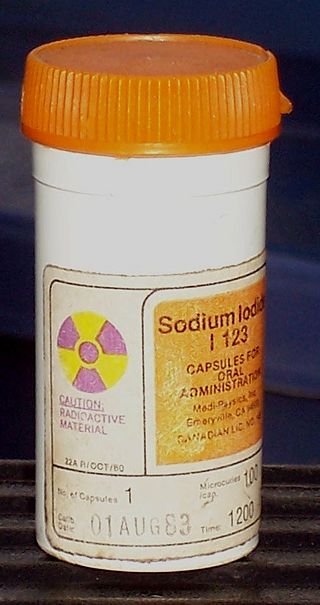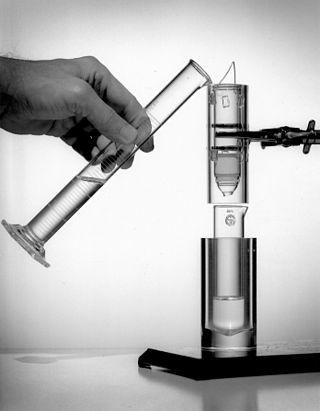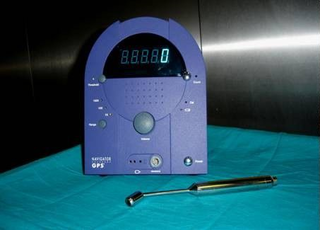
Radiopharmacology is radiochemistry applied to medicine and thus the pharmacology of radiopharmaceuticals. Radiopharmaceuticals are used in the field of nuclear medicine as radioactive tracers in medical imaging and in therapy for many diseases. Many radiopharmaceuticals use technetium-99m (Tc-99m) which has many useful properties as a gamma-emitting tracer nuclide. In the book Technetium a total of 31 different radiopharmaceuticals based on Tc-99m are listed for imaging and functional studies of the brain, myocardium, thyroid, lungs, liver, gallbladder, kidneys, skeleton, blood and tumors.
Pegfilgrastim, sold under the brand name Neulasta among others, is a PEGylated form of the recombinant human granulocyte colony-stimulating factor (GCSF) analog filgrastim. It serves to stimulate the production of white blood cells (neutrophils). Pegfilgrastim was developed by Amgen.
Technetium (99mTc) fanolesomab is a mouse monoclonal antibody formerly used to aid in the diagnosis of appendicitis. It is labeled with a radioisotope, technetium-99m (99mTc).

Technetium-99m (99mTc) is a metastable nuclear isomer of technetium-99, symbolized as 99mTc, that is used in tens of millions of medical diagnostic procedures annually, making it the most commonly used medical radioisotope in the world.

Technetium (99mTc) medronic acid is a pharmaceutical product used in nuclear medicine to localize bone metastases as well as other diseases that can alter the natural turn-over in the bone by bone scintigraphy.
Technetium 99mTc albumin aggregated (99mTc-MAA) is an injectable radiopharmaceutical used in nuclear medicine. It consists of a sterile aqueous suspension of Technetium-99m (99mTc) labeled to human albumin aggregate particles. It is commonly used for lung perfusion scanning. It is also less commonly used to visualise a peritoneovenous shunt and for isotope venography.

An octreotide scan is a type of SPECT scintigraphy used to find carcinoid, pancreatic neuroendocrine tumors, and to localize sarcoidosis. It is also called somatostatin receptor scintigraphy (SRS). Octreotide, a drug similar to somatostatin, is radiolabeled with indium-111, and is injected into a vein and travels through the bloodstream. The radioactive octreotide attaches to tumor cells that have receptors for somatostatin. A gamma camera detects the radioactive octreotide, and makes pictures showing where the tumor cells are in the body, typically by a SPECT technique. A technetium-99m based radiopharmaceutical kit is also available.

Fosaprepitant, sold under the brand names Emend (US) and Ivemend (EU) among others, is an antiemetic medication, administered intravenously. It is a prodrug of aprepitant.

A gamma probe is a handheld device containing a scintillation counter, for intraoperative use following injection of a radionuclide, to locate sentinel lymph nodes by their radioactivity. It is used primarily for sentinel lymph node mapping and parathyroid surgery. Gamma probes are also used for RSL, to locate small and non-palpable breast lesions.
Turoctocog alfa is a recombinant antihemophilic factor VIII used for the treatment of and prophylaxis of bleeding patients with haemophilia A. It is marketed by Novo Nordisk. It was approved in the United States, the European Union, and Japan in 2013.
Netupitant/palonosetron, sold under the brand name Akynzeo, is a fixed-dose combination medication used for the prevention of acute and delayed chemotherapy-induced nausea and vomiting. It is marketed and distributed by Helsinn Therapeutics. Netupitant is an NK1 receptor antagonist and palonosetron is a 5-HT3 receptor antagonist.
Insulin degludec/liraglutide, sold under the brand name Xultophy, is a fixed-dose combination medication for the treatment of adults with type 2 diabetes to improve glycemic control in combination with diet and exercise. It contains insulin degludec and liraglutide. It is administered by subcutaneous injection.
Burosumab, sold under the brand name Crysvita, is a human monoclonal antibody medication approved 2018 for the treatment of X-linked hypophosphatemia and tumor-induced osteomalacia.
A PSMA scan is a nuclear medicine imaging technique used in the diagnosis and staging of prostate cancer. It is carried out by injection of a radiopharmaceutical with a positron or gamma emitting radionuclide and a prostate-specific membrane antigen (PSMA) targeting ligand. After injection, imaging of positron emitters such as gallium-68 (68Ga), copper-64 (64Cu), and fluorine-18 (18F) is carried out with a positron emission tomography (PET) scanner. For gamma emitters such as technetium-99m (99mTc) and indium-111 (111In) single-photon emission computed tomography (SPECT) imaging is performed with a gamma camera.

Patisiran, sold under the brand name Onpattro, is a medication used for the treatment of polyneuropathy in people with hereditary transthyretin-mediated amyloidosis, a fatal rare disease that is estimated to affect 50,000 people worldwide.
Efmoroctocog alfa, sold under the brand name Elocta among others, is a medication for the treatment and prophylaxis of bleeding in people with hemophilia A. Efmoroctocog alfa is a recombinant human coagulation factor VIII, Fc fusion protein (rFVIIIFc). It is produced by recombinant DNA technology in a human embryonic kidney (HEK) cell line.
Damoctocog alfa pegol, sold under the brand name Jivi is a recombinant DNA-derived, Factor VIII concentrate medication used to treat hemophilia A.

Lenacapavir, sold under the brand name Sunlenca, is an antiretroviral medication used to treat HIV/AIDS. It is taken by mouth or by subcutaneous injection.

Gallium (68Ga) gozetotide or Gallium (68Ga) PSMA-11 sold under the brand name Illuccix among others, is a radiopharmaceutical made of 68Ga conjugated to prostate-specific membrane antigen (PSMA) targeting ligand, Glu-Urea-Lys(Ahx)-HBED-CC, used for imaging prostate cancer by positron emission tomography (PET). The PSMA targeting ligand specifically directs the radiolabeled imaging agent towards the prostate cancerous lesions in men.

Technetium (99mTc) mertiatide is a radiopharmaceutical medication used in nuclear medicine to image the kidneys. It is a renal imaging agent that is given by intravenous injection.










